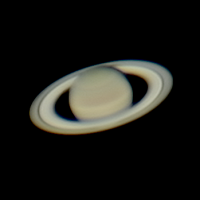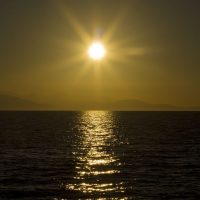New Moon will occur today at 17:12HST.
This coming weekend, Aug. 3rd, offers an excellent dark night with a slim 3 day old Moon. Get out and enjoy the dark!
Continue reading “New Moon”When you want to see the stars, find someplace dark
Sky events
New Moon will occur today at 17:12HST.
This coming weekend, Aug. 3rd, offers an excellent dark night with a slim 3 day old Moon. Get out and enjoy the dark!
Continue reading “New Moon”Today Mercury is passing through inferior conjunction, passing between the Sun and the Earth. This fast moving planet will reappear above the dawn in about a week, rising towards maximum elongation on August 9th.
This is a modest apparition, with the planet reaching only 19° away from the Sun.
| Mercury Events for 2019 | |||
|---|---|---|---|
| Apparition | Date | Elongation | Magnitude |
| Evening | Feb 27 | 18.1°E | -0.2 |
| Morning | Apr 11 | 27.7°W | +0.6 |
| Evening | Jun 23 | 25.2°E | +0.7 |
| Morning | Aug 9 | 19.0°W | +0.3 |
| Evening | Oct 20 | 24.6°E | +0.1 |
| Morning | Nov 28 | 20.1°W | -0.3 |
| Data from the Mercury Chaser’s Calculator by John Walker | |||
Full Moon will occur today at 11:38HST.
This evening look for the Moon rising in the east just as the Sun sets in the west. Across the Big Island this can often lead to moonbows as the low elevation moonlight interacts with fog and clouds.
A partial lunar eclipse will be visible in Europe, India, and Africa. None of this eclipse will be visible here in the islands.
Continue reading “Full Moon”This evening, July 15th, the Moon will pass quite close to Saturn. For viewers in the islands the pair will be closest as it grows dark, slowly separating as the night advances.
At sunset the two will be separated by about 40 arcminutes. Keep in mind that is a center to center distance, considering the size of the moon this puts the planet about 25 arcminutes from the limb of the Moon, close enough to appear in the field of a medium power eyepiece in most amateur telescopes.
Viewers in the South Pacific and Australia will be able to view an occultation of Saturn by the Moon this evening.
As the Moon is also quite close to full it will be rising at sunset, thus a good eastern horizon is desirable to see this event early in the evening. Look for a bright, slightly yellowish star-like object just north of the Moon as it rises.
Today the planet Saturn will pass through opposition, directly opposite the Sun in our sky.

Saturn orbits the Sun once every 29.45 years. As the ringed planet continues on its way the Earth swings around much faster on our inside track. As a result we lap Saturn once every 378.1 days, passing between the planet and the Sun. During opposition Saturn will be well placed for observation all night long, rising at sunset, transiting at midnight, and setting at sunrise.
During opposition the planet and rings will be slightly brighter than normal, an effect known as the opposition effect. The effect is most notable in the rings where the apparent brightness can increase by 30%. The effect is a combination of two factors, shadow hiding and the retro-reflective properties of the ring particles.
Lāhainā Noon is that moment when the Sun is directly overhead. At the moment of Lāhainā Noon shadows disappear.
The first Lāhainā Noon of the year occurs in May as the Sun is moving northwards in the sky. The second chance to see Lāhainā Noon is in July as the Sun moves back to the south.
The table below gives the dates and times for this second Lāhainā Noon across the islands.
| Lahiana Noon for July 2019 | |||||
|---|---|---|---|---|---|
| City | Long. | Lat. | Date | Time | Elevation |
| Naalehu | 155°35’W | 19°03’N | Jul 27 | 12:29HST | 89.9 |
| Hilo | 155°05’W | 19°42’N | Jul 24 | 12:27HST | 89.9 |
| Kona | 155°59’W | 19°39’N | Jul 25 | 12:30HST | 89.9 |
| Waimea | 155°40’W | 20°01’N | Jul 23 | 12:29HST | 89.9 |
| Hawi | 155°50’W | 20°14’N | Jul 22 | 12:30HST | 89.9 |
| Hana | 156°00’W | 20°46’N | Jul 19 | 12:30HST | 89.9 |
| Kihei | 156°27’W | 20°45’N | Jul 19 | 12:32HST | 90.0 |
| Kahalui | 156°28’W | 20°53’N | Jul 18 | 12:32HST | 89.9 |
| Lahaina | 156°40’W | 20°53’N | Jul 18 | 12:33HST | 89.9 |
| Lanai City | 156°55’W | 20°50’N | Jul 18 | 12:34HST | 89.9 |
| Kaunakakai | 157°01’W | 21°05’N | Jul 17 | 12:34HST | 89.9 |
| Honolulu | 157°49’W | 21°18’N | Jul 16 | 12:37HST | 89.9 |
| Kaneohe | 157°48’W | 21°25’N | Jul 15 | 12:37HST | 89.9 |
| Waialua | 158°08’W | 21°34’N | Jul 14 | 12:38HST | 89.9 |
| Lihue | 159°22’W | 21°58’N | Jul 11 | 12:43HST | 89.9 |
| Data from US Naval Observatory Data Services | |||||
Earth’s apehelion will occur at 12:11HST today.

Apehelion occurs when the Earth reaches its furthest distance from the Sun for the year.
It may seem odd to some the apehelion occurs in the middle of summer. One must recall that the distance from the Sun is not the cause of our seasons, that is the effects of axial tilt.
| 2019 Apsides and Seasons | ||||
|---|---|---|---|---|
| Event | Universal Time | Hawaii Standard Time | ||
| Perihelion | Jan 03 | 05:20UT | Jan 02 | 19:20HST |
| Spring Equinox | Mar 20 | 21:58UT | Mar 20 | 11:58HST |
| Summer Solstice | Jun 21 | 15:54UT | Jun 21 | 05:54HST |
| Aphelion | Jul 04 | 22:11UT | Jul 04 | 12:11HST |
| Fall Equinox | Sep 23 | 07:50UT | Sep 22 | 21:50HST |
| Winter Solstice | Dec 22 | 04:19UT | Dec 21 | 18:19HST |
| Data from US Naval Observatory Data Services | ||||
New Moon will occur today at 09:16HST.
A total solar eclipse will cross the South Pacific and South America today.
This coming weekend, July 6th, offers a slim 4 day old moon, a good night to get out and enjoy the dark.
Continue reading “New Moon”Today Mercury is passing through maximum elongation, the furthest it will rise above the setting Sun in the evening sky. After today the planet will slide back into the Sun’s glare headed for inferior conjunction on July 21st.
This is the most favorable evening apparition of the year, reaching over 25° from the Sun. The October apparition is almost as good
reaching over 24° from the Sun.
The summer solstice will occur at 05:54HST today.
The Sun has reached the most northerly declination it will achieve this year. After today the Sun begins to move south in our skies.
Today will be the longest day of the year for those of us located in the northern hemisphere.
Today is considered the start of summer for most cultures in the northern hemisphere, or the start of winter for those in the southern hemisphere.
| 2019 Apsides and Seasons | ||||
|---|---|---|---|---|
| Event | Universal Time | Hawaii Standard Time | ||
| Perihelion | Jan 03 | 05:20UT | Jan 02 | 19:20HST |
| Spring Equinox | Mar 20 | 21:58UT | Mar 20 | 11:58HST |
| Summer Solstice | Jun 21 | 15:54UT | Jun 21 | 05:54HST |
| Aphelion | Jul 04 | 22:11UT | Jul 04 | 12:11HST |
| Fall Equinox | Sep 23 | 07:50UT | Sep 22 | 21:50HST |
| Winter Solstice | Dec 22 | 04:19UT | Dec 21 | 18:19HST |
| Data from US Naval Observatory Data Services | ||||